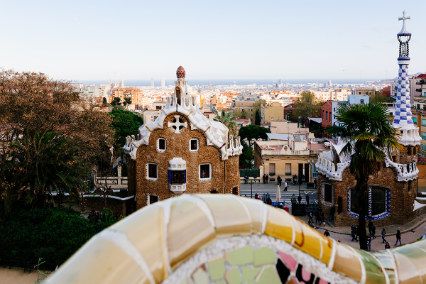
Published 31st Jul. 2024
Reading time
Cerulean skies, cobalt blue seas and stunning mountainscapes; we could be describing any one of the 11 idyllic islands that together make up the Balearics and the Canaries. Both long-time favourites among British holidaymakers, it’s finally time for a head-to-head between these two Spanish island groups to see how they compare when it comes to climate, beaches and overall good-time vibes. So cast aside any preconceptions of partying and package holidays and read on to find out who will triumph in the Spanish island stand-off between the Balearic Islands vs Canary Islands.
For some, the name ‘Mallorca’ might conjure up images of all-inclusive resorts and ‘Brits Abroad’. But in truth, there’s so much more to the Balearic Islands. Mallorca is the quartet’s jack-of-all-trades, promising panoramic mountain views, dreamy beaches and bustling towns in equal measure. Stay in boutique hotels tucked between tiny villages, explore the honey-hued capital of Palma, or charter a boat and sail between hidden coves. Menorca and Formentera are the more chilled-out siblings of the archipelago. White-washed villages take precedence over party towns, while history buffs will love the architecture of Mahón (Menorca’s charming capital) and the prehistoric sites of Talayotic. In Formentera, the pace of life can be even slower; fill your days with beach hopping, ocean floating and mouth-watering Mediterranean food. Although Ibiza has garnered somewhat of a party reputation, there are still plenty of tranquil corners and wellness-focused retreats to be found across the island. All four Balearic beauties can cater to whichever vibe you desire.
The Canary Islands also do an excellent job of appealing to all. Again, certain islands have a reputation for attracting partygoers, but look beyond these hedonistic hotspots and you’ll find rugged nature, stunning suntraps and plenty of adventure activities. Lanzarote has its fair share of resort towns, but also dramatic volcanic scenery, a rugged coastline and sleepy fishing villages. Tenerife is the most frequented of the seven islands that make up the archipelago; stray away from the self-contained pockets of mass tourism and you’ll find lively towns in the north, such as La Laguna and La Orotava, filled with impressive architecture and local dining options. The lesser-visited islands of El Hierro, La Palma and La Gomera are best suited to those looking to stretch their legs. A UNESCO-listed geopark in its own right, El Hierro’s hilly terrain is tailor-made for hikers, while Parque Nacional de la Caldera de Taburiente in La Palma and La Gomera’s Parque Nacional de Garajonay both play host to rewarding walking routes.
For their effortlessly cool character and endless charm, the Balearic Islands nudge ahead in this round; the competition commences with one-nil on the scoreboard.

The Balearics sit pretty in the Mediterranean Sea off the eastern coast of Spain, affording them a year-round Mediterranean climate, characterised by warm summers and mild winters. Expect to see temperatures upwards of 30°C between June and September, dropping to the mid-teens in spring and autumn. Winters are by no means extreme (and rainfall tends to be minimal), however the weather can change quickly and does differ between regions due to the mountainous terrain. This makes the Balearic Islands a surefire spring and summer destination, with most people choosing to visit between April (when the almond blossom reigns supreme) and October.
The Canary Islands, on the other hand, are blessed with a subtropical climate, thanks to their location off the northwestern coast of Africa. Sometimes referred to as ‘eternal spring’, the temperatures tend to hover between 18 and 24°C throughout the year. Rainfall is also low, particularly on the eastern islands of Lanzarote and Fuerteventura. The archipelago’s Atlantic address makes it a prime target for winter sun seekers.
This year-round suitability gives the Canary Islands the edge for this round of the Balearic Islands vs Canary Islands showdown, bringing the score to one all.

The culture, cuisine and climate of both island groups form a tempting trifecta, but if there’s one thing that they really excel at, it’s sand and sea. Both the Balearics and the Canaries are blessed with breath-taking beaches; this is a key reason why a colossal 17.8 million tourists visited Mallorca last year, and 14.1 million boarded flights bound for the Canary Islands. Cala Gracioneta, Cala Olivera and Punta Galera have all made a name for themselves among Ibiza’s beachy elite, while Cala Macarella, Macarelleta and Turqueta are often touted as Menorca’s standout sandy strips. Our favourite Mallorquin playas include Cala Deià, Es Trenc and Caló des Moro.
For golden sand in Gran Canaria, head to Las Canteras beach in Las Palmas or Maspalomas in the south. Tenerife comprises craggy volcanoes bordered by buttery sand, and Playa del Duque in Costa Adeje is one of the most well-known, while Lanzarote plays host to the well-loved Playa Blanca and Puerto del Carmen. Sotavento on Fuerteventura in the Canaries is not only renowned as a suntrap for soaking up the rays, but windsurfers, kitesurfers and wingfoilers flock here to take advantage of the blustery breeze.
Since both archipelagos boast a wealth of sand strewn treasures, we’re calling this round a draw, taking the score to two all in this contest of the Balearic Islands vs Canary Islands. Instead of taking this to penalties, we’ll use it as an excuse to visit both...

Written by Luisa Watts

Want to experience Spain like a local? We can help you get under the country’s skin, from Green Spain’s mountains to the Balearic Islands’ sun-soaked coasts. Fear not about missing out on the country’s popular spots, as we can help source tickets to sites like the Alhambra (even when it’s sold out) and advise on the best times to avoid the crowds. Our in-country Concierges can provide tried and tested tips, from secret eateries in Seville to pointing you towards Catalonia’s oldest lighthouse. When it’s time to hit the hay, we’re constantly on the lookout for properties with the best locations, restaurants and ways to relax.
ENQUIRE NOWPractical advice and inspiration for your next trip

Sick of relentless rain and constant colds? It’s time for a winter getaway. Many people think of Spain as a summer spot, but we’re firm believers that Barcelona is breathtaking whatever the weather. From sparkling Christmas markets and ornate cathedrals to buzzing bars and tasty tapas, there are a million reasons to visit Barcelona in winter. Lucky for you, we’ve compiled a shortlist of the top five.
21st May 2025 - Spain Travel Inspiration

Easter in Seville is a whole lot more than chocolate eggs and fuzzy yellow chicks. Known as Semana Santa (Holy Week), the seven-day celebration spans from Palm Sunday to Easter Sunday and is one of Spain’s most deeply rooted Catholic traditions. In Seville, schools shut, some workplaces close and the whole city pitches in to honour the Passion of Jesus Christ with processions, floats and flamenco-style prayers.
20th February 2025 - Spain Culture

With lush parks springing to life and rooftop bars filling with sun-seekers, what better time to visit Barcelona than in spring? Whether you want to join the Sant Jordi celebrations, marvel at the view from Montjuic Castle, dig your feet into honey-hued sands or meander through the city’s winding streets, this season has plenty to offer. Read on for our carefully curated guide on what to do in spring
27th January 2025 - Spain Travel Inspiration

Our team of destination experts will get to know you and your unique requirements for your holiday

We work with you to build an ultra-personalised holiday itinerary with your choice of accommodation, experiences and activities

All of our holidays include little extras designed to make a big difference to your trip, from fast-tracking you through airport check-in and security to our network of local Concierges